Silage films made from biopolymers
A team of researchers at Hof University of Applied Sciences wants to banish conventional plastic silage films from the fields and develop a bio-based alternative with better properties.

After the harvest, straw bales wrapped in white plastic film dominate the landscape of many fields. In these so-called silage bales, fodder crops such as corn are turned into food for cattle through lactic acid fermentation. But the films used for this purpose are anything but environmentally friendly. They are made of conventional plastic and have been shown to leave traces of microplastics in the soil. "In addition - and this is particularly regrettable - they have so far been purely disposable and thus bad for the eco-balance," explains Isabell Kleiber. She is a research associate at the Institute for Applied Biopolymer Research (Institut für angewandte Biopolymerforschung; ibp) at Hof University of Applied Sciences.
Compostable and recyclable
As part of the "Agri-Stretch" project, Kleiber and her team want to develop sustainable silage films made of biopolymers that are also biodegradable. In order to do this, they are experimenting with two bioplastics made from renewable raw materials: PLA and PBAT. "Our goal is that in the future the films will be made of 100% renewable raw materials. Instead of disposable materials, we want to develop a product that is compostable or recyclable and can therefore be perfectly integrated into the agricultural production cycle," says Kleiber.
Adding better properties to biobased films
Replacing silage film with a biobased variant would be too simple, however. The research group is well aware that their material must impress with better properties in order to compete on the market with petroleum-based films, which are still cheaper. "First and foremost, the film must demonstrate a 400% elongation at break. That means you have to be able to stretch it a lot without it tearing. It also has to be UV resistant, since it will usually be outdoors for a full year. And, of course, it also has to be impermeable to water and oxygen, because otherwise the fermentation process in the silage won't work," explains Kleiber.
Good results in feasibility studies
Biodegradable stretch film is being developed as part of the BioSiFo project. Feasibility studies are currently being carried out and initial results are promising. Investigations showed that the required properties can best be achieved using a three-layer film, with each layer covering a different requirement. Technical investigations are to start as early as next year with a practical partner. The project is being financed by the Agency for Renewable Resources. In addition, the Hof University of Applied Sciences is also working on a degradable mulch film that is intended to release nutrients when it decomposes in the soil.
bb


